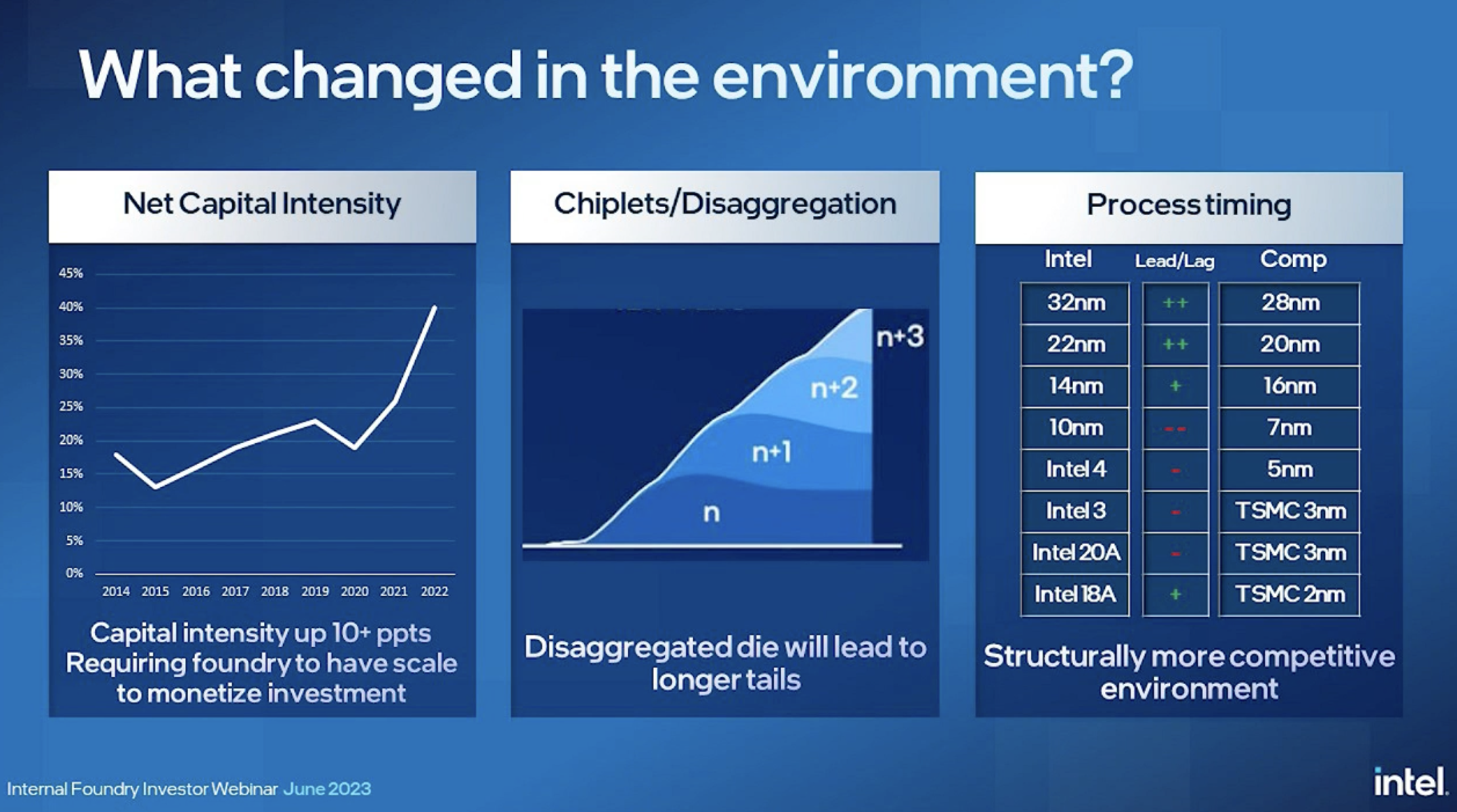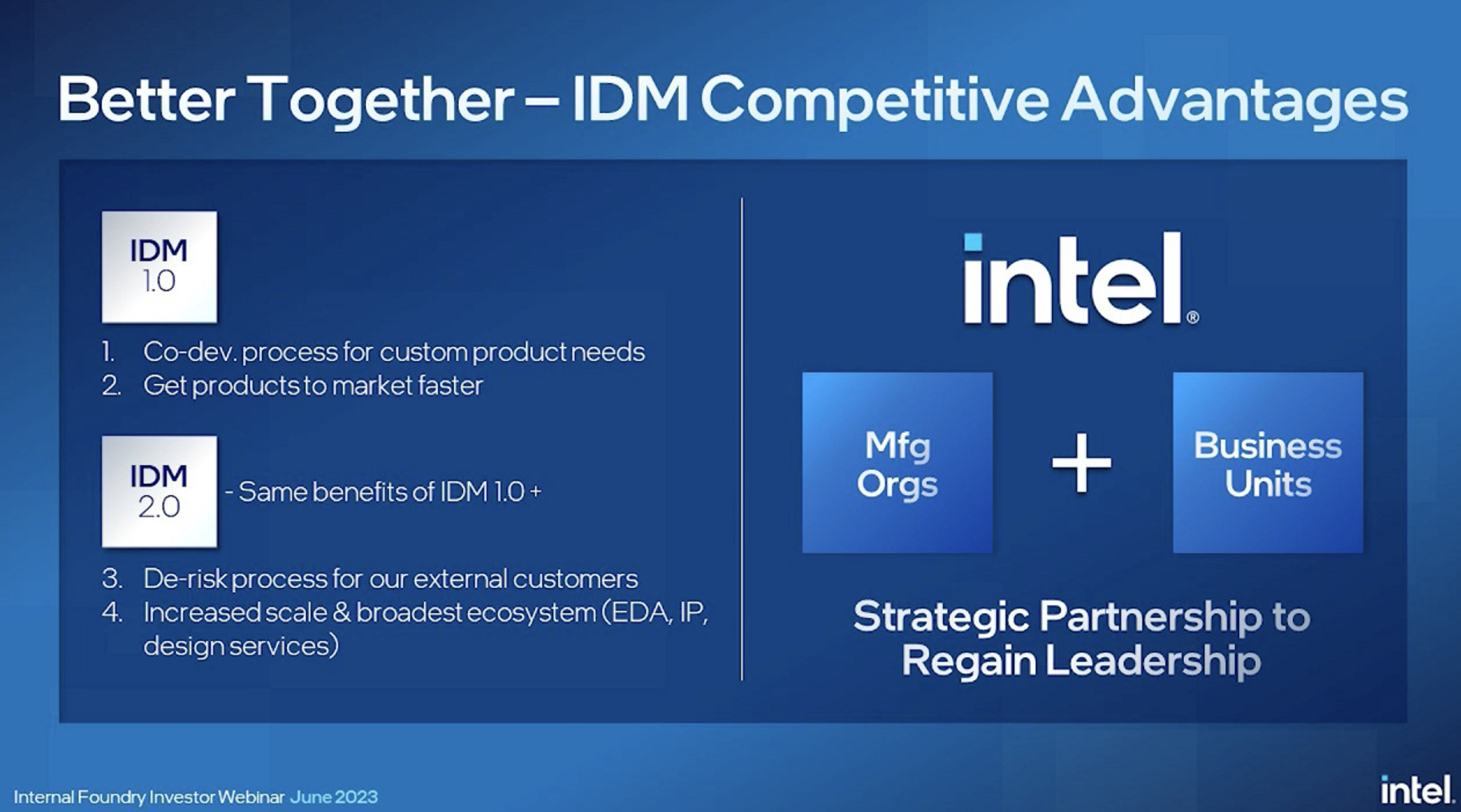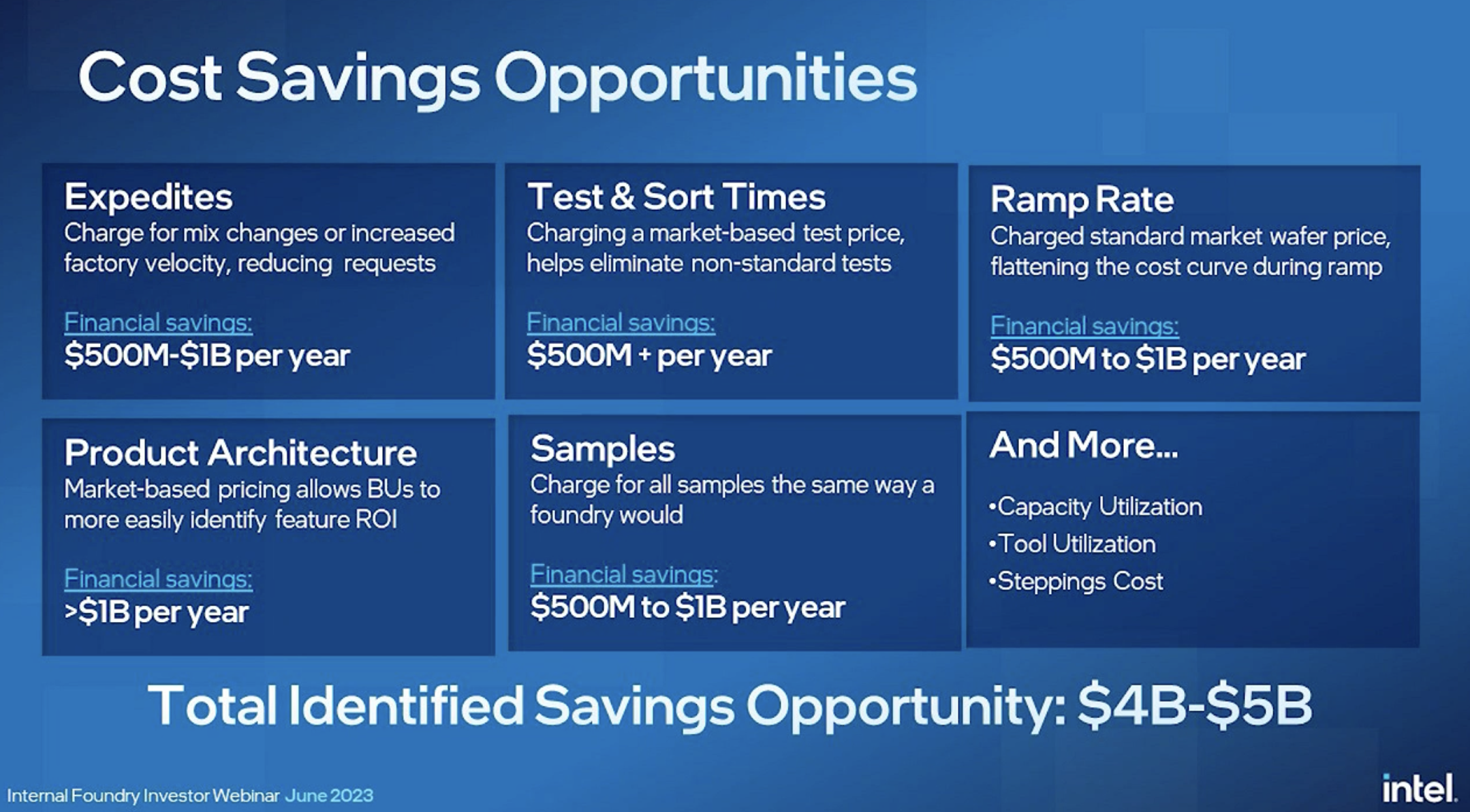Intel to Operate Foundry and Manufacturing More Like a Separate Business
Internal Foundry Services and manufacturing will report their own profit and loss.

Intel is kicking its internal foundry model into high gear. Today, on a call with investors, David Zinsner, executive vice president and chief financial officer, and Jason Grebe, corporate vice president and general manager of corporate planning, detailed how Intel's manufacturing group, including Internal Foundry Services, will be broken out into its own profit and loss (P&L) statement.
Zisner and Grebe suggested this new IDM 2.0 model will put Internal Foundry Services along with manufacturing and technology development into a reportable unit, who will sell to both external fabless customers and internal business units that will choose to use either Intel's foundries or external competitors. (Intel already has some x86 chips being made at TSMC like the upcoming Meteor Lake processors.)
Intel stated that its IDM 1.0 strategy worked for a long time, but the capital required to create new leading edge nodes has increased, and there has been a lag behind rivals in a competitive business environment. Intel does claim, however, that its Intel 18A will come in 2025 and regain process leadership.




The company states that it's still the goal for the Internal Foundry Model to produce the second-largest external foundry in the industry. It claims that putting this group in its own P&L will also lead to $8 billion to $10 billion in "cost reduction opportunities." including ramp rates and test and sort times based on a "market-based" price. It is likely, however, to start with a negative operating margin.
Intel also suggests that keeping the foundry in its own company will provide benefits to external customers. Intel says it will have five internal products on 18A, and suggests that by creating multiple products on a node internally before releasing to external customers, it "de-risks" the node for those outside partners, with more wafer starts and the kinks removed from the process.
Grebe reiterated that there will be a "compete segregation" of customer data and intellectual property, along with "world class" service and support and an affirmation that there is supply available for customers. Intel will have to compete with the likes of TSMC and other fabs both with external customers and inside Intel to ensure its success.
When asked why Intel isn't simply splitting into a fabless design business and a separate foundry business, Zisner said that "we think there is a ton of benefit for having both a product business and a manufacturing business combined." Those benefits, he suggested, include better process technologies and products due to internal teams collaborating, and using internal teams as "customer zero" to increase volumes on new nodes. Zisner suggested he didn't see any requirement to split the business in two. That being said, it seems clear that it is a possibility in the future, where Intel could spin its foundry out.
Get Tom's Hardware's best news and in-depth reviews, straight to your inbox.

In recent weeks, Intel has recently announced plans for huge investments, including an assembly plant in Poland a $25 billion plant in Israel. These are on top of billions of dollars on new fabs in Oregon and Arizona, as well as a site in Magdeburg, Germany.
Intel stock was down approximately 4.9% on the news.

Andrew E. Freedman is a senior editor at Tom's Hardware focusing on laptops, desktops and gaming. He also keeps up with the latest news. A lover of all things gaming and tech, his previous work has shown up in Tom's Guide, Laptop Mag, Kotaku, PCMag and Complex, among others. Follow him on Threads @FreedmanAE and BlueSky @andrewfreedman.net. You can send him tips on Signal: andrewfreedman.01
-
JamesJones44 Will they really get to choice who they want to be their foundry or will it be like other conglomerates?Reply
A lot of conglomerate P&Ls are setup like this, but are highly encouraged (aka forced) to use the internal conglomerates businesses for "competitive reasons" or as I like to call it, making investors happy that the new baby is doing well while they strangle the old one to death. -
ikjadoon Instead of listening to Intel talk about Intel IDM, take a gander what IDM's would-be customers say behind closed-doors:Reply
Mobile-phone chip giant Qualcomm and carmaker Tesla have explored having Intel produce chips for them, then backed off, according to executives involved in the discussions.
Elon Musk’s Tesla passed because Intel couldn’t provide extensive chip-design services that other major foundries offer, one of those people said.
Qualcomm dialed back after technical missteps by Intel, according to some of those involved in the interaction. Gelsinger declined to comment on Intel’s relationships with Qualcomm and Tesla.
In early 2022, Intel’s foundry arm sent a delegation to Qualcomm’s San Diego headquarters, where they met with CEO Cristiano Amon. Then Intel missed a June performance milestone toward producing those chips commercially. It missed another in December. Qualcomm executives concluded Intel would struggle making the kind of cellphone chips they wanted, even if it succeeded in making high-performance processors. Qualcomm told Intel it was pausing work while it waits for Intel to show progress, according to people involved in the discussions.
Intel is firmly the "Exynos" of the foundry + PC CPU design industry: bizarre management choices, staunch addiction to overpromising, and shamelessly murders efficiency to avoid admitting their uArch + node is way behind.
Nobody wants to compete with Intel on Intel's fabs because you will always lose against the house:
2011: "There were two reasons we didn't go with them. One was that they are just really slow. They're like a steamship, not very flexible. We're used to going pretty fast. Second is that we just didn't want to teach them everything, which they could go and sell to our competitors," Jobs is quoted as saying.
2023: “Essentially, we argue Intel likely splits into a foundry business and a fabless product business, and the segment P&L is a big first step.” Arcuri said. “Such a separation is necessary because there is not a single potentially significant customer that tells us they would make a big commitment to Intel foundry as long as it would be competing with Intel for the best wafers, highest yielding lots, etc.”
The problem with Intel IDM is Intel, and too many clutch their pearls when people say that a much more serious split is the bare minimum. "But, but, being a fab is in Intel's DNA! They have Pat now! You'll destroy Intel without its fabs! There goes Intel's unique value proposition ."
Not a single company today is following Intel's insane model because of how disgustingly perfect you have execute on it. It just means missed targets after missed targets after missed targets.
Intel is about 20+ years behind the foundry service industry, but only in the past year have they barely begun to admit it. That sucks for Intel because admitting your mistakes is not the same as fixing your mistakes; that takes another 20+ years. -
bit_user ReplyIntel already has some x86 chips being made at TSMC like the upcoming Meteor Lake processors.
Correction: they make the GPU tiles at TSMC, not the x86 core tiles! Not much different to how they've been using TSMC to make their Alchemist dGPU chips.
So, a better characterization of Intel's relationship with TSMC is that they have been & will continue using TSMC for their GPU chip(let) manufacturing.
Wow, this is a pretty significant admission:
That's pretty clearly stating even their 20A node isn't expected to get them parity with TSMC N3!
And: "Manufacturing Group to have stand alone on P&L"
This is basically the last step before a spinoff. -
thestryker Reply
I think you're reading Intel's poorly done slide wrong. It's titled process timing with the left side being Intel's node and the right side being the TSMC equivalent and the middle column being their execution time. They're acknowledging that they've messed up big time on their timing which makes sense since the first N3 should be out this year and 20A isn't until next.bit_user said:Wow, this is a pretty significant admission:
That's pretty clearly stating even their 20A node isn't expected to get them parity with TSMC N3! -
TerryLaze Reply
They will never risk ending up like AMD having to fight for very small amounts of waffers that prevent them from making money even at the times that they have a good product.bit_user said:This is basically the last step before a spinoff.
Especially not since their CPU department makes them all their money while the (external) foundry business is not safe at all.
Apparently you missed this slide...
They will be releasing 4 products (CPU gens? or mobile cores->e-cores->p-cores? ) on a node before releasing it to external customers.
-
bit_user Reply
That's your opinion. I think Intel cares more about what Wall St. thinks.TerryLaze said:They will never risk ending up like AMD having to fight for very small amounts of waffers that prevent them from making money even at the times that they have a good product.
That's exactly why they want to separately track P&L of the foundry business and do cost optimizations. Their goal is make it self-sufficient and show when that's been accomplished. Then, they can "cut the cord" and unchain that boat anchor from their design operations and really start raking in the profits.TerryLaze said:Especially not since their CPU department makes them all their money while the (external) foundry business is not safe at all.
No, I saw it. People are very good at justifying the status quo. Once the situation changes, they'll find some reason why they no longer need to be in-house, like maybe establishing a special partner program or something.TerryLaze said:Apparently you missed this slide...
They will be releasing 4 products (CPU gens? or mobile cores->e-cores->p-cores? ) on a node before releasing it to external customers.
Those execs get paid the big bucks for just this sort of thing. -
TerryLaze Reply
How is it an boat anchor if it is at least self-sufficient?!bit_user said:That's exactly why they want to separately track P&L of the foundry business and do cost optimizations. Their goal is make it self-sufficient and show when that's been accomplished. Then, they can "cut the cord" and unchain that boat anchor from their design operations and really start raking in the profits.
Yeah, because waiting in line, maybe not getting enough waffers and paying a big overhead to the FAB is a great way of raking in profits.bit_user said:Then, they can "cut the cord" and unchain that boat anchor from their design operations and really start raking in the profits.
Intel produces enough things in a high enough number for the FABs to be worth it, it's not like AMD where they didn't have enough market share to produce enough stuff for the FABs to make sense anymore. -
bit_user Reply
Because it dilutes (or "drags down") the profits of the design side of the company.TerryLaze said:How is it an boat anchor if it is at least self-sufficient?!
Just like all other supply-chain issues, it would have to be managed. What caught AMD off-guard is the pandemic-related demand surge that not only exceeded their up-front wafer purchases, but also put them in a bidding war with other TSMC customers for more capacity that they'd previously assumed would be available for the taking (thus, why they didn't buy more up-front).TerryLaze said:Yeah, because waiting in line, maybe not getting enough waffers and paying a big overhead to the FAB is a great way of raking in profits.
It's not as if Intel having its own fabs made it immune from supply shortages.
https://www.anandtech.com/show/15132/intel-publishers-letter-to-customers-apologizing-for-cpu-shipment-delays
At one point, Intel sales reps went as far as advising Xeon customers to use AMD EPYC. I'll post a link to the article, if I can find it.
Furthermore, Intel says its wants its fabs to have to compete for the business of its design groups, and for those groups to have the felxibility to shop around. Both mentioned in the last panel of this slide:
Not any more, they don't. That's why IDF 2.0, as the first panel of this slide shows:TerryLaze said:Intel produces enough things in a high enough number for the FABs to be worth it,
I don't see why you're so threatened. Furthermore, arguing with me won't change anything. Intel is going to do what makes sense for its finances. I'm just reading the tea leaves. Maybe I'm wrong or perhaps you disagree, but it will have no bearing on what they do. -
TerryLaze Reply
Self-sufficient means the bottom line is at least zero or positive so how would it drag down anything?bit_user said:Because it dilutes (or "drags down") the profits of the design side of the company.
Why would you think that I'm threatened?! I'm just using common sense.bit_user said:I don't see why you're so threatened.
Yes, the addition FAB space would be a huge challenge to always keep busy enough with only intel fabbing there, but getting customers through IDM 2 or with the FAB as a separate entity would not change the end result. Spinning it off won't make them magically get more or less customers, any customer paranoid enough to not use IDM won't see any difference and would also not use a spin off FAB. -
bit_user Reply
You understand the concept of dilution, right? Let's say the fabs cost $x and merely break even. Meanwhile, the CPU business unit has costs of $y and achieves a profit of $z. Having the fabs and processor group in one financial entity means its profits are $z / ($x + $y). If the fabs were spun out, then the processor group would be reporting profits of $z / $y, which is much more attractive to investors.TerryLaze said:Self-sufficient means the bottom line is at least zero or positive so how would it drag down anything?
You seem to be arguing they shouldn't change, and yet they are. I'm just trying to explain the rationale for their evolution. I don't know where your defensiveness is coming from, but it ultimately makes no difference because their corporate decisions are based on business principles and financial realities - not what any number of random forum posters think.TerryLaze said:Why would you think that I'm threatened?! I'm just using common sense.
We can agree to disagree on that. As long as the foundry business has a financial incentive to help Intel's design groups, I think there will naturally be more suspicion about leaks and anti-competitive behavior.TerryLaze said:Spinning it off won't make them magically get more or less customers, any customer paranoid enough to not use IDM won't see any difference and would also not use a spin off FAB.



